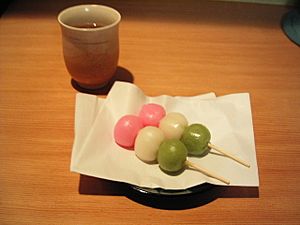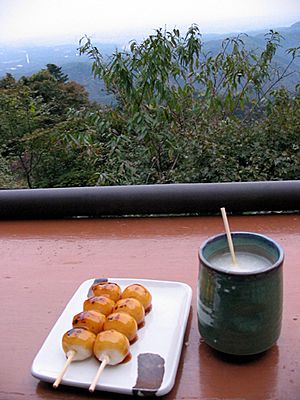Dango facts for kids
Dango is a yummy Japanese treat. It's a type of dumpling made from special rice flour called mochiko. Dango is often sticky and very filling. People usually enjoy it with a cup of green tea.

People eat Dango all year round in Japan. But different kinds are traditionally eaten in certain seasons. Often, three or four Dango balls are served together on a skewer. In Hokkaidō, a region in Japan, some Dango is made from potato flour. It is baked and served with shoyu, which is soy sauce.
There's a famous Japanese proverb related to Dango. It's "Hana yori dango" (花より団子, which means "dumplings rather than flowers"). This saying is about the custom of cherry blossom viewing, called hanami. It means that practical things (like yummy Dango) can be better than just beautiful things (like flowers).
Different Kinds of Dango
There are many different types of Dango. They are usually named after the special toppings or seasonings served with them.
- Botchan dango: This Dango comes in three colors. One is colored with red beans, another with eggs, and the third with green tea. You might see Botchan dango in Japanese anime. It's a common snack during hanami (cherry blossom viewing).
- Chichi dango: This type is slightly sweet. People usually eat it as a dessert after a meal.
- Goma: This Dango is covered in sesame seeds. It has a mix of sweet and salty flavors.
- Kinako: This Dango is coated in a toasted soy flour. It has a unique nutty taste.
- Kushi dango: This is a general name for Dango balls served on a skewer. Kushi means skewer.
- Mitarashi: This Dango is covered in a sweet and salty syrup. The syrup is made from shoyu (soy sauce), sugar, and starch. Mitarashi Dango is very popular with kids and adults alike.
- Nori: This Dango is wrapped in dried and seasoned seaweed. It offers a savory taste.
- Kibidango: This type of Dango is made from millet. It's a traditional dumpling.
Images for kids
-
Tsukimi dango (Moon-viewing Dango)
See also
In Spanish: Dango para niños




